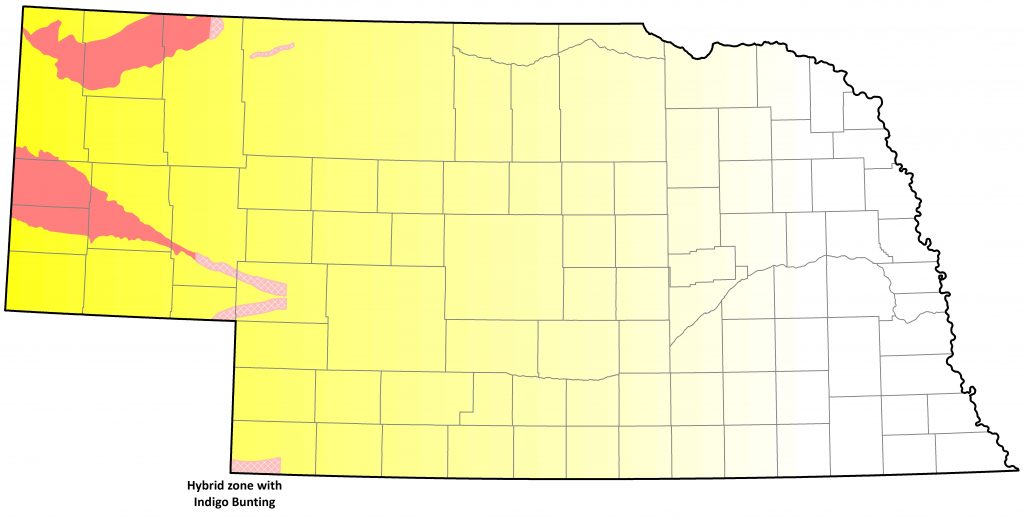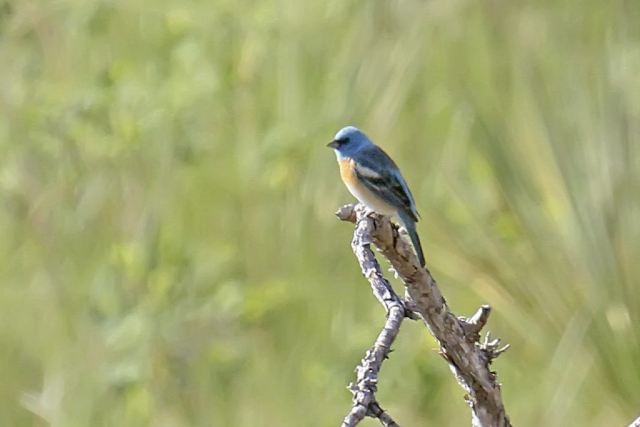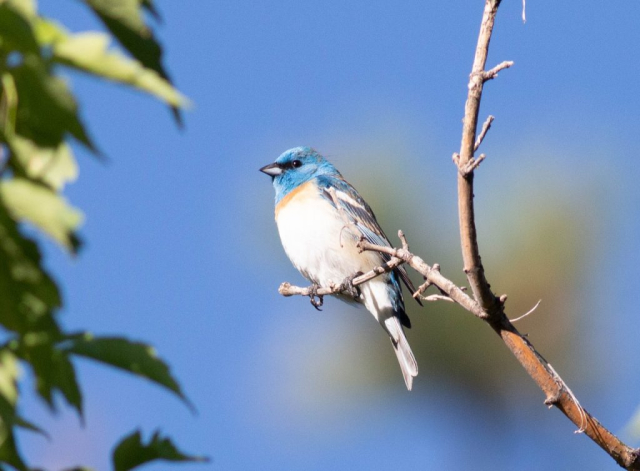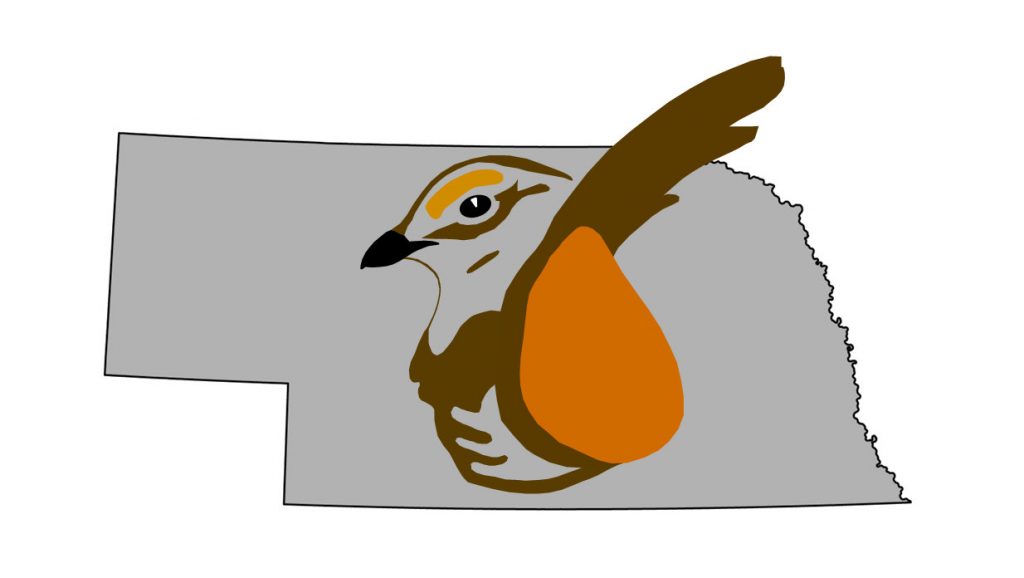Passerina amoena
Status: Fairly common regular spring and fall migrant west and west central, uncommon east central and east. Uncommon regular breeder west, rare casual north.

Documentation: Specimen: UNSM ZM10346, 11 Jul 1910 Glen, Sioux Co.
Taxonomy: No subspecies are recognized (Gill et al 2022).
This species and Indigo Bunting hybridize; for a discussion see the Lazuli x Indigo Bunting (hybrid) species account.
Spring: Apr 28, 28, 28 <<<>>> May 27, 27, 27 (away from breeding range)
An earlier date is 22 Apr 1990 Dundy Co (Grzybowski 1990).
Later dates away from breeding range are 30 May 1997 Richardson Co, 1 Jun 2009 Dixon Co, 2 Jun 2015 Nuckolls Co, and 5 Jun 2001 Knox Co.
Migrants arrive in early May.
Migrants have been reported statewide; reports from the east have increased since 2000; as of 2024 there were about 97 such reports 28 Apr-5 Jun, over half since 2013. In 2020, there were 11 reports in the east 2-25 May, all of single birds.
- High counts: 19 in Carter Canyon, Scotts Bluff Co 5 Jun 2020, 16 near Chadron, Dawes Co 24 May 2022, and 14 at Buffalo Creek Pond, Banner Co 21 May 2021.
- A “wave” of 8 was in Adams Co 24 May 1938 (Staley 1938).
Summer: Currently, breeding is probably restricted to the Pine Ridge in Sioux and Dawes Cos, the Wildcat Hills and Scotts Bluff NM areas in Scotts Bluff Co, Bighorn Escarpment in Scotts Bluff and Banner Cos, and possibly the Niobrara Valley Preserve, Brown Co.
Although Johnsgard (1980) stated that Lazuli Bunting bred east to eastern Cherry Co, although recent reports are few. There are no recent breeding season reports between the Pine Ridge and eastern Cherry Co, suggesting that summering Lazuli Buntings in the Niobrara Valley from Valentine eastward, if they continue to occur there, are disjunct and may be at risk of extirpation by genetic swamping by Indigo Bunting. One was in Cherry Co 28 Jul 2009, and singles were at Valentine NWR 3 Jul 2015 and at Fort Niobrara NWR 8 Jul 2008. Brogie and Mossman (1983) found several singing male Lazulis, albeit outnumbered 40:1 by Indigos, and considered Lazuli Buntings to have “certainly nested” in the preserve (Mossman and Brogie 1983). One was at the preserve in Brown Co 10 Jun 2024. Mollhoff (2001) showed summer occurrences in Keya Paha/Brown Cos in the period 1984-89. There are recent reports there 19 Jun 2015 and of three on 28 Jun 2015. One was about three miles east of Niobrara, Knox Co 5 Jun-3 Jul 2001, and one was found on a BBS route in Knox and Antelope Cos between 1967 and 1977. Ed Brogie found a nest with eggs as far east as Hoskins, Wayne Co 10 Jul 1977 (Mollhoff 2022), and a singing male was in Dixon Co 2 Aug 2004.
An old easterly report of possible breeding is of a male at Hastings, Adams Co 18 May 1935 that was joined by a female; on 4 Jun, four males and two females were present (Swenk 1935). Brooking collected eggs (HMM #2268) from a nest at Spring Branch, Clay Co 23 Jun 1915 (Mollhoff 2022).
Elsewhere, there are scattered nesting season (Jun-Jul) reports east of the expected breeding range, none accompanied by evidence of nesting. One was in Thomas Co Jun 2008. At Crescent Lake NWR, Garden Co there are four reports 2-17 Jun that are likely migrants, although one was there 1 Jul 1977. There are several reports in Keith Co that might indicate breeding: at Lake Ogallala 2 Jun 2007, 7 Jun 2011, 8 Jun 2011, and 17 Jun 2001, for Keith Co Jul-Aug 1977 (Rosche and Johnsgard 1984), 21 Jul 2016, and territorial singing males 5 Jul 1987 and 25 Jul 1984 (Rosche 1994). In Lincoln Co there are several reports also: 30 Jun 1965, 30 Jun 1966, 22 Jun 2003, one singing 8-19 Jul 2010., and one 7 Jun 2024. One was at Bridgeport SRA, Morrill Co 18 Jun 2023, one at Oliver Reservoir, Kimball Co 22 Jun 2023, and one at Red Willow Reservoir, Frontier Co 15 Jul 2010.
In addition, there are reports for Chase Co 4 Jul 1989, 1-2 on 13-18 Jun 2009, 12 Jun 2013, and during the second breeding bird atlas 2006-2011 there were reports in Chase, Dundy, and Hitchcock Cos (Mollhoff 2016). Mollhoff (2001) showed summer occurrences in Furnas and Custer Cos in the period 1984-89.
Reports in summer in the east are not expected and are probably overshoot spring migrants; these are 5 Jun 1962 Platte Co, 11 Jun 1976 Douglas-Sarpy Cos, 19 Jun 1983 Otoe Co, and 19 Jun 2004 York Co.
- Breeding phenology:
Eggs:23 Jun- 10 Jul (Mollhoff 2022)
Fledglings: 19 Jul-1 Aug - High Counts: 14 at Buffalo Creek WMA, Scotts Bluff Co 23 Jun 2023, 13 at Carter Canyon, Scotts Bluff Co 13 Jun 2022, 11 along Old Stage Road, Scotts Bluff Co 14 Jun 2021, 11 at Ponderosa WMA, Dawes Co 8 Jul 2023, and 11 at Cedar Canyon WMA, Scotts Bluff Co 13 Jun 2024.
Fall: summer <<<>>> Oct 4, 4, 4
Departure begins in Jul-Aug and is usually completed by late Sep.
Later dates tend to be easterly; these are 6 Oct 2019 Douglas Co, 10 Oct 1975 Sarpy Co “excellent details” (Williams 1976), and 13 Oct 1916, a male specimen, HMM 2829, taken at Inland, Clay Co.
There are a few reports in fall away from breeding areas other than those cited above: 6 Jul 1977 Wayne Co, 8 Jul 2009 Lincoln Co, 15 Jul 2010 Frontier Co, 15 Jul 2023 Hitchcock Co, 9 Aug 2020 Dundy Co, and 1 Oct 2016 Loup Co.
Lazuli Bunting begins fall molt on the breeding grounds but suspends it to undertake a molt migration to the southwestern USA, where the molt is completed (Greene et al 2020).
High counts: 22 in East Ash Canyon, Dawes Co 5 Sep 2015, 6 at Oliver Reservoir, Kimball Co 19 Aug 2021, 5 at Wind Springs Ranch, Scotts Bluff Co, 25 Aug 2001, 5 at Wright’s Gap Road, Scotts Bluff Co 4 and 12 Aug 2018, and 5 at Carter Canyon, Scotts Bluff Co 6 Aug 2023.
Images
Abbreviations
BBS: Breeding Bird Survey
HMM: Hastings Municipal Museum
NM: National Monument
NWR: National Wildlife Refuge
SRA: State Recreation Area
UNSM: University of Nebraska State Museum
WMA: Wildlife Management Area (State)
Literature Cited
Brogie, M.A., and M.J. Mossman. 1983. Spring and summer birds of the Niobrara Valley Preserve, Nebraska: An annotated checklist. NBR 51: 44-51.
Gill, F., D. Donsker, and P. Rasmussen (Eds). 2022. IOC World Bird List (v 12.2). Doi 10.14344/IOC.ML.12.2. http://www.worldbirdnames.org/.
Greene, E., V.R. Muehter, and W. Davison. 2020. Lazuli Bunting (Passerina amoena), version 1.0. In Birds of the World (A. F. Poole, Editor). Cornell Lab of Ornithology, Ithaca, NY, USA. https://doi.org/10.2173/bow.lazbun.01.
Grzybowski, J.A. 1990. Southern Great Plains Region. American Birds 44: 454-457.
Johnsgard, P. A. 1980. A preliminary list of the birds of Nebraska and adjacent Great Plains states. Published by the author, University of Nebraska, Lincoln, USA.
Mollhoff, W.J. 2001. The Nebraska Breeding Bird Atlas 1984-1989. Nebraska Ornithologists’ Union Occasional Papers No. 7. Nebraska Game and Parks Commission, Lincoln, Nebraska, USA.
Mollhoff, W.J. 2016. The Second Nebraska Breeding Bird Atlas. Bull. Univ. Nebraska State Museum Vol 29. University of Nebraska State Museum, Lincoln, Nebraska, USA.
Mollhoff, W.J. 2022. Nest records of Nebraska birds. Nebraska Ornithologists’ Union Occasional Paper Number 9.
Mossman, M.J., and M.A. Brogie. 1983. Breeding Status of selected bird species on the Niobrara Valley Preserve, Nebraska. NBR 51: 52-62.
Rosche, R.C. 1994. Birds of the Lake McConaughy area and the North Platte River valley, Nebraska. Published by the author, Chadron, Nebraska, USA.
Rosche, R.C., and P.A. Johnsgard. 1984. Birds of Lake McConaughy and the North Platte River Valley, Oshkosh to Keystone. NBR 52: 26-35.
Staley, A.H. 1938. A wave of migrating Lazuli Buntings at Hastings, Adams Co. NBR 6: 32.
Swenk, M.H. 1935. The 1935 Migration Season [Spring 1935]. NBR 3: 87-113.
Williams, F. 1976. Southern Great Plains Region. American Birds 30: 90-95.
Recommended Citation
Silcock, W.R., and J.G. Jorgensen. 2025. Lazuli Bunting (Passerina amoena). In Birds of Nebraska — Online. www.BirdsofNebraska.org
Birds of Nebraska – Online
Updated 23 Jun 2025


